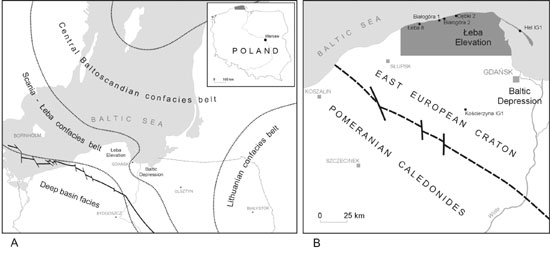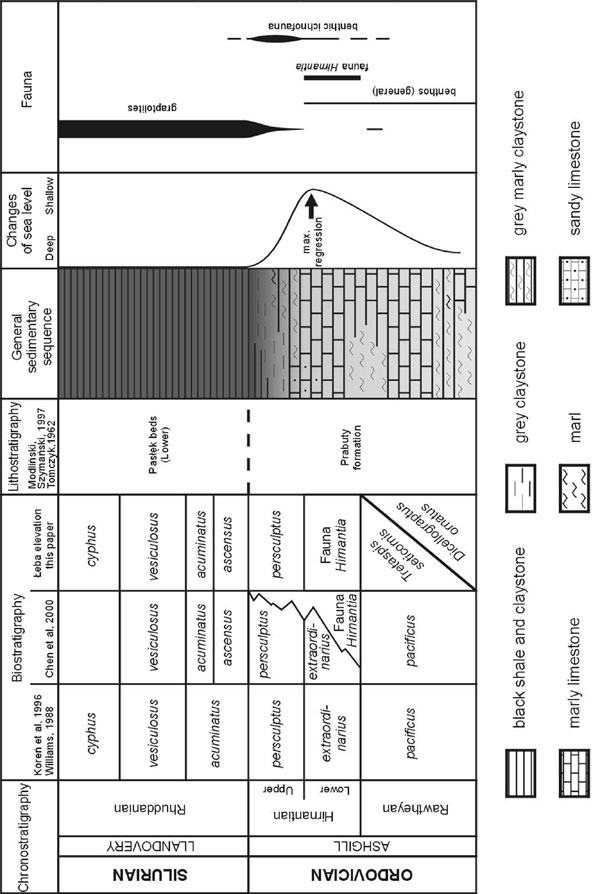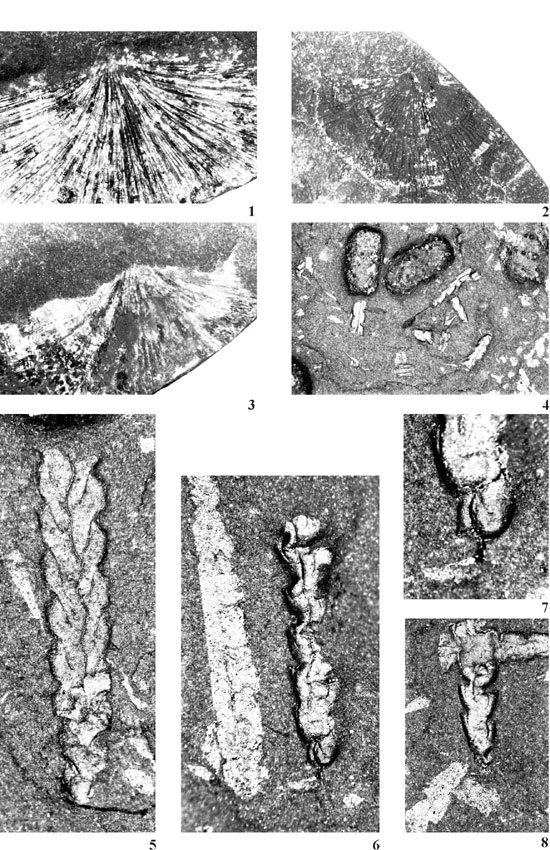
Late Ordovician to Early Silurian transition and the graptolites from Ordovician/Silurian boundary near the SW rim of the East European Craton (northern Poland)
Teresa Podhalańska1
1 Polish Geological Institute, 00-975 Warszawa, ul. Rakowiecka 4. E-mail: tpod@pgi.waw.pl
Key words: Graptolites. Biostratigraphy. Ordovician–Silurian boundary. East European Craton. Poland.
Introduction
Latest Ordovician to earliest Silurian is an important geological period marked by distinct paleontological, paleoenvironmental and paleogeographical changes. However, in many parts of the world the O/S transition is not complete. A present study of the strata and fauna of near the Ordovician/Silurian boundary in the complete sections in northern Poland has provided some interesting stratigraphical results as well as gave an insight into the biodiversity of graptolite and benthic assemblages from near the Ordovician/Silurian boundary zone, their stratigraphical ranges and associations.
Geological setting
The Upper Ordovician and the Lower Silurian transitional deposits are exposed in Poland only in the Holy Cross Mts. and in Sudetes, but they have been recognized in the numerous boreholes of the Polish Lowlands. From the west to the east of the Baltic Depression (northern Poland) there are represented all facies belts of the Baltic basin: from the basin facies in the west through the slope, deep- and shallow-neritic to the onshore facies in the east (Figure 1A). The Ordovician/Silurian transitional deposits discussed in this study are known from the deep boreholes of Leba Elevation, situated in Scanian confacies belt very close by the rim of the East European Craton. They were formed in the outer part of the epicontinental sea covering the stable platform which was situated in the late Ordovician and the early Silurian in the moderate palaeolatitudes. Further to the west the Ordovician and Silurian deposits are folded and crushed and represent the Pomeranian Caledonides The most complete Upper Ashgill – Lower Llandovery succession was studied in a few cores presented on Figure 1B.
An analysis of the litho- and biofacies in the uppermost Ordovician and the lowermost Silurian strata of the Leba Elevation indicate strong similarities between the development of this region and that of Scania and Bornholm. Latest Ordovician to earliest Silurian strata known from the area from near the rim of East European Craton originated in the epicontinental basin of Baltoscandia which was characterized by an extremely low average rate of sediment accumulation. The thickness of the O/S transition beds does not exceed a few meters.

Figure 1. A. Locality map and distribution of facies zones in the Baltic region. B. Location map of the study area.
Ordovician/Silurian boundary interval – depositional sequence
The deposits of the latest Ordovician to the earliest Silurian change gradually their lithology as well as colour and fauna. The Ashgillian is developed as grey marly limestones, marls and marly claystones of Prabuty Fm (Modliński, Szymański, 1997) with benthic fauna of trilobites and brachiopods and in the upper part with Hirnantia fauna (Podhalańska, 1980, 1999). In the upper part of these deposits the fine- to medium-grained, poorly sorted quartz wacke occurs. The main constituents are poorly rounded, rarely sharp-edged quartz grains and the lithoclasts with only small amount of feldspar, muscovite and rare glauconite. Quartz is mainly terrigenous but metamorphic and volcanic quartz grains also occur. The sandy laminae occur in the uppermost part of the lower Hirnantian and indicate the periods of increased terrigenous material supply connected with the sea-level drop and glacioeustatic regression caused by the Late Ordovician glacial event. A connection of the supply of the coarse-grained sediment to the depositional area with the tectonic events occurring at that time in the Törnquist Ocean is not excluded.
The detail investigation of the O/S boundary interval indicates a gradual transition from light, marly deposits with benthic fauna to dark, clayey shales with graptolites without clear break in sedimentation (comp. Figure 2). The first graptolites were found in dark grey, slightly marly claystones with ichnofossils: horizontal burrows and coprolites, directly above the Hirnantia fauna. It indicates that the first graptolites preceded the final change from oxic, limy deposits to anoxic clayey shales.
In the uppermost Ordovician to lowermost Silurian the following sedimentological sequence can be observed:
– grey marly limestone with Hirnantia fauna
– grey marly claystone with ichnofossils (numerous horizontal feeding and dwelling burrows) and rare graptolites
– grey but not black claystone with graptolites
– black claystone with numerous graptolites but also with coprolites
– black claystone exclusively with graptolites
The gradational contact has been observed also in south Sweden (Scania) (Bergström et al, 1999; Nilsson, 1979).
Biozonation
A present paper is based on recently collected fauna from near the boundary zone as well as the lowermost Silurian of the deep borings from the Leba Elevation. Based on the continuous sections a complete succession including graptolite biozones as well as shelly faunas has been recognized. The generalized stratigraphy is shown on Figure 2.
Hirnantia fauna
The well-known and world-wide distributed Hirnantia fauna has been recognized in Poland not once (Podhalańska, 1980, 1999; Temple, 1965; Tomczyk and Tomczykowa, 1976). In the investigated material the Hirnantia fauna occurs above the layers with Dicellograptus ornatus or Tretaspis seticornis, which are the equivalents of the Paraorthograptus pacificus Biozone. The diversity of the Hirnantia fauna is not great but it is characterized by the typical association: Hirnantia, Eostropheodonta, Plectothyrella and Dalmanella (Plate 1).

Figure 2. General section across the Ordovician/Silurian boundary in the Leba elevation.
Normalograptus persculptus Biozone
The first graptolites of "near the boundary zone" appear in dark grey, slightly marly claystones or grey (not black) claystones, where they occur together with the ichnofossils. It indicates that the first graptolites preceded the facial change to dark clay-rich and bituminous-rich facies with graptolites unequivocally indicating the base of the Silurian and appeared still during oxic or, at most, suboxic conditions. The presence of the persculptus biozone has been cited earlier in the other section from this area by Tomczyk (1982). The assemblage of persculptus Biozone found in the investigated area is similar to the Dob’s Linn standard assemblage (Williams, 1983; 1988) and Baltica (Bjerreskov, 1975; Koreń and Bjerreskov, 1997). The oldest graptolite fauna contains only biserial graptolites, predominately normalograptids (Plate 1): N. angustus, N. cf. persculptus, N. normalis and N. avitus. Normalograptus avitus Davies with characteristic bifurcated virgella is cited in Poland for the first time. This genus which is also characteristic for the persculptus Biozone of Dobs’Linn is thought to be an evolutionary ancestor of akidograptinae (Melchin, 2001).
Akidograptus ascensus Biozone
In the Leba Elevation, above the oldest graptolite assemblage the number of graptolites clearly increases. The author’s investigation confirm that similar as in many parts of the world as well as in Dobs’Linn (Melchin and Williams, 2000) a distinct interval with abundant A. ascensus occurs below the first appearance of P. acuminatus. This stratigraphic interval is recognized as a separate ascensus biozone (Chen et al., 2000; Koreń and Rickards, 1996; Štorch and Loydell, 1996; Melchin, 2001; Melchin and Williams, 2000). It should be stressed that this agrees very well with the graptolite zonation of Teller (1969) who distinguished two separate biozones: ascensus and acuminatus as the lowermost Silurian biozones in Poland. According to this explanation the basal of the Silurian System is the Akidograptus ascensus Biozone.
Besides the nominative form the N. normalis, N. medius, N. angustus, Neodiplograptus modestus and Paraclimacograptus innotatus innotatus have been found in this biozone.
The following biozones: acuminatus Biozone, vesiculosus Biozone and cyphus Biozone have been established in the investigated sections as a range zones with their typical graptolite associations.
Conclusions
In the continuous sections of the Leba Elevation, near the western rim of the East European Craton, a complete succession of the late Ordovician to earliest Silurian has been recognized. The gradational transition of the lithofacies and biofacies in the Ordovician/Silurian boundary interval has been stated. Based on the study of a few sections the standard graptolite biozones as well as Hirnantia fauna have been established. The oldest graptolites of the persculptus Biozone preceded the facial change from oxic or suboxic claystones to the anoxic bituminous shales. As well as in many other sections in the world A. ascensus appears below the first appearance of P. acuminatus. Two different biozones: ascensus and acuminatus have been distinguished. According to the recent assumptions the lower boundary of the ascensus Biozone is the lower boundary of Silurian System.

Plate 1. 1, 2, 3. The latest Ordovician Hirnantia brachiopod fauna, Hel IG-1 section. 4. Graptolites of the lowermost part of ascensus Biozone together with the coprolites, Hel IG-1 section. 5-8. The first graptolites above the Hirnantia Fauna: 5. N. cf. persculptus, form in slight relief; 6, 7. N. avitus, with bifurcated virgella, form in relief; 8. The young form of ?A. ascensus or ?A. ascensus n.ssp. Hel IG – 1 section.
Acknowledgments
This paper is a contribution to the project 6.20.1324.00.0 "Hirnantian and Rhuddanian graptolites and Ordovician/Silurian boundary in the western part of the East European Platform (Leba Elevation)".
References
Bergström, S.M., Huff, W. D., Koreń, T., Larsson, K., Ahlberg, P. and Kolata, R. 1999. The 1997 core drilling through Ordovician and Silurian strata at Röstanga, S Sweden: prelimunary stratigraphic assessment and regional comparison. GFF, 121: 127-135.
Bjerreskov, M. 1975. Llandoverian and Wenlockian graptolites from Bornholm. Fossils and Strata, 8: 1-95.
Chen Xu., Jiayu R., Mitchell, C.D., Harper, D.A.T., Junxuan, F., Renbin, Z., Yuandong, Z., Rongyu Li, Wang Yi. 2000. Late Ordovician to Earliest Silurian graptolite and brachiopod biozonation from the Yangtze region, South China, with a global correlation. Geological Magazine, 137 (6): 623-650.
Koreń, T.N., Rickards, R. B. 1996. Taxonomy and evolution of Llandovery Biserial Graptoloids from the Southern Urals, Western Kazakhstan. Special Papers in Palaeontology, 54: 1-100.
Koreń,, T., Bjerreskov, M. 1997. Early Llandovery monograptids from Bornholm and the southern Urals: taxonomy and evolution. Geological Society of Denmark, 44 (1): 1-100.
Melchin, M. J. 2001. The GSSP for the base of the Silurian System. Silurian Times, 9.
Melchin, M.J., Williams, S. H. A. 2000. A restudy of the akidograptine graptolites from Dob’s Linn and a proposed redefined zonation of the Silurian Stratotype. Palaeontology Down Under 2000. Geological Society of Australia, Abstracts: 61-63.
Modliński, Z., Szymański, B. 1997. The Ordovician lithostratigraphy of the Peribaltic Depression (NE Poland). Kwart. Geol. 41 (3): 273-288.
Nilsson, R. 1979. A boring through the Ordovician-Silurian boundary in western Scania, south Sweden. Sver. Geol. Unders. Serie C, 766: 1-18.
Podhalańska, T. 1980. Stratigraphy and facial development of Middle and Upper Ordovician deposits in the Leba Elevation (NW Poland). Acta Geologica Polonica, 30 (4): 327-390.
Podhalańska, T. 1999. The Upper Ordovician and the Lower Silurian in the Peribaltic depression: stratigraphy and development. Acta Univ. Carolinae, 43 (1/2): 221-224.
Štorch, P., Loydell, D.K. 1996. The Hirnantian graptolites Normalograptus persculptus and "Glyptograptus" bohemicus: Stratigraphical consequences of their synonymy. Palaeontology, 39: 869-881.
Teller, L. 1969. The Silurian biostratigraphy of Poland based on graptolites. Acta Geol. Pol., 19 (3): 393-501.
Temple, J. T. 1965. Upper Ordovician brachiopods from Poland and Britain. Acta Palaeont. Pol., 10: 379-427.
Tomczyk, H. 1982. Sylur. W: Profile głębokich otworów wiertniczych IG, 54. Kościerzyna IG-1.
Tomczyk, H., Tomczykowa, E. 1976. Development of Ashgill and Llandovery sediments in Poland. Proceedings of a Palaeont. Assoc. Symp. Birmingham: 327-347.
Williams, H. 1983. The Ordovician – Silurian boundary graptolite fauna of Dob’s Linn, southern Scotland. Palaeontology, 26 (3): 605-641.
Williams, H. 1988. Dob’s Linn – The Ordovician – Silurian boundary stratotype. In: A global analysis of the Ordovician – Silurian boundary (eds. Cocks L. R. M., Rickards R. B. ). Bull. British Mus. Nat. Hist. Geology, 43: 17-30.
Received: February 15, 2003
Accepted: June 15, 2003